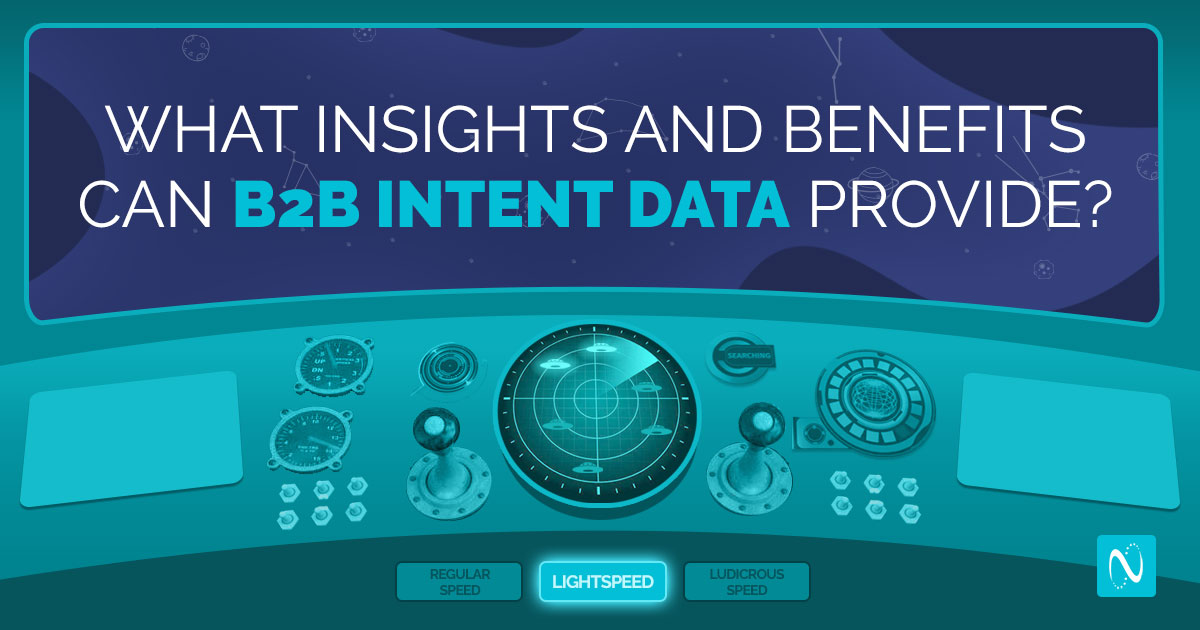We’ve covered the topic of buyer-level intent data in many posts on the NetLine blog, including an overview of ‘What Exactly Is B2B Intent Data?’ and ‘Why Intent Data Matters’.
In this post, we’ll take a closer look at what sort of insights B2B intent data can provide marketers and sales professionals, along with some of the benefits they can expect when they take full advantage of such data.
What Insights Can B2B Intent Data Provide?
B2B marketers can collect a huge amount of data from their own online properties and from across the web. However, most of the data trail that is left by B2B buyers isn’t relevant.
For example, a visit to a tech review site doesn’t provide much insight if they are just browsing reviews for their own product. The same goes for a visit to a trade publisher site; it doesn’t indicate much if they are simply reading a random opinion piece during a coffee break.
Data that can identify real intent, however, is powerful for a whole number of reasons. So what types of insights can intent data provide?
At a high-level, some key insights that intent data can provide include:
- Intent signals that indicate when a potential customer is in-market for a particular solution — for example when a buyer downloads a “Buying Guide” or visits a web page comparing different vendors, they may be actively looking for a solution or considering it in the near future.
- Key topics and themes that buyers meeting your Ideal Customer Profile are researching — these can be either on your own properties or on other sites across the web.
- Insights into the buyer’s journey and potential pain points — for example, the search terms and engagement history of known, qualified accounts can be used to create content and update your messaging.
At this point, it’s important to note that any insights coming from intent data will always be more powerful when they come from buyer-level intent data rather than those aggregated at the account-level. The reason for this is simple: if you know who the individual is, you will automatically know what account they belong to.
To demonstrate this further, here’s a more detailed list of potential insights and what they can offer at the account-level and at the buyer-level.
| Potential Insights from intent data | Why this might be useful at an account-level | Why these insights at a buyer-level offer more than at an account-level |
| Intent signals for specific solutions | Identifies interested companies | Enables personalized outreach targeted at named buyers, leading to improved efficiency and better buyer experiences |
| Topics and themes being researched | Reveals organizational interests for content strategy | Unearths decision-makers’ interests, allowing for more relevant and personalized content |
| Keywords and phrases used in searches | Assists in SEO for company attraction | Content and ads can be tailored and targeted to individuals, improving paid media efficiency and boosting conversion rates |
| Engaged content and websites | Indicates online platforms for targeting | Reveals preferred content/websites of individuals, enabling better targeting and personalization |
| Geographic and firmographic data | Aids in segmentation and market analysis | Provides insights into individual preferences and potential cultural or regional considerations, enabling more personalized marketing strategies |
| Technographic data | Reveals company technology preferences | Indicates a buyer’s familiarity with certain tech, assisting in tailoring demos or technical discussions |
| Social media activity and sentiment | Shows company sentiment towards a product/solution | Reveals individual sentiments, which can be crucial in personalizing communication and addressing concerns |
| Buyer’s journey and pain points | Unveils common company challenges | Helps to anticipate and address specific pain points of individual buyers, improving the buying experience |
| Account-based marketing insights | Prioritizes and customizes messaging for high-value accounts | Enables highly personalized messaging and targeting for high-intent individual buyers, increasing conversion rates |
| Customer preferences and buying behaviors | Provides an overview of company buying decisions | Offers in-depth knowledge of individual decision-making patterns, enabling more effective and timely sales approaches |
| Effective channels and campaigns | Optimizes marketing budget across companies | Identifies the most effective channels and campaigns for individual buyers, leading to better engagement and conversion rates |
| Effective messaging and offers | Reveals resonating messaging/offers with companies | Offers insights into what specific messaging and offers work for individual buyers, enabling highly personalized marketing |
| Segments and industries showing need | Guides targeting/segmentation strategies | Helps in understanding individual roles and responsibilities, allowing for personalized engagement strategies |
| Resonating content and offers for personas | Enables persona-targeted content/offers | Assists in creating highly personalized content and offers based on individual preferences and needs, boosting engagement and conversion |
| Competitive landscape and market positioning | Gauges company positioning among competitors | Provides knowledge of individual perceptions, informing personalized positioning strategies |
| Upsell and cross-sell opportunities | Identifies accounts for more business | Helps identify individual users interested in additional products or services, allowing for personalized upsell strategies |
| Potential customer objections | Understands common company objections | Reveals individual buyer’s objections, allowing for personalized objection handling and negotiation, increasing chances of deal closure |
| Impact of external factors on Intent | Assesses impact of market trends/events on company demand | Offers insight into individual reactions to market events, aiding in personalized communication during these times |
5 Key Benefits of Using Intent Data in B2B Marketing
Now that you know what intent data is, the next question that comes to mind is likely to be, how does using it benefit B2B marketing? There are several key benefits to using intent data in your B2B marketing. Here are a few:
- Improved lead generation through buyer discovery: Buyer-level intent data, which identifies prospects on an individual level, enables you to see who is actively searching for solutions like yours. By knowing exactly who is researching your solutions or products, you can focus on high-intent prospects, thereby improving the quality of the leads that you pass to sales and increasing the likelihood of converting them into customers.
- Increased conversion rates through targeting and monitoring: On the topic of conversions, by targeting prospects who are more likely to be interested in your offerings, you can improve your conversion rates. Intent data allows you to tailor your messaging and content to the needs and interests of your target audience. Furthermore, by monitoring the behavior of prospects within accounts that are already expressing intent, you can time any marketing and sales outreach at exactly the right moment.
- Better personalization in both marketing and sales outreach: Intent data provides insights into the topics, keywords, and content that your target audience is engaging with. Using this data, especially when it’s at a buyer level, allows marketers to personalize messaging and content, as well as outreach and communications, to better align with the interests of potential buyers. Later in this post, we’ll explain more thoroughly how intent data can be used to improve targeting and personalization.
- Improved paid media efficiency through better timing, targeting, and tailored content: Intent data offers a competitive edge for B2B marketers by enhancing paid media efficiency. By unveiling a prospect’s buying stage, intent data enables precision in timing, targeting potential leads when they’re most receptive. Additionally, understanding a prospect’s needs facilitates more accurate targeting, ensuring ads reach decision-makers who are truly interested eliminating guesswork and unqualified leads. Intent data bridges the gap between your offering and the buyer’s needs, optimizing ad spend and transforming paid media from a blunt tool to a scalpel of precision marketing.
- Enhanced ROI: Improving ROI is always one of the top goals of any B2B organization. It’s also one of the key benefits of utilizing intent data. Because intent data allows marketers to focus resources on high-intent prospects, time, effort, and budget are not wasted on courting prospects that are not ready to convert.
Of course, the above benefits are just an overview.
Exactly what you can get from intent data is up to how you use it to its full potential.
If you’re truly looking to learn how to get the most from intent data, NetLine’s INTENTIVE is the best in the business. INTENTIVE offers real-time insights into “who” is actively expressing intent inside an account, while also being the lone intent platform to deliver “what” actions that person is taking, “when” those actions took place, and notably “where” those actions occurred.

